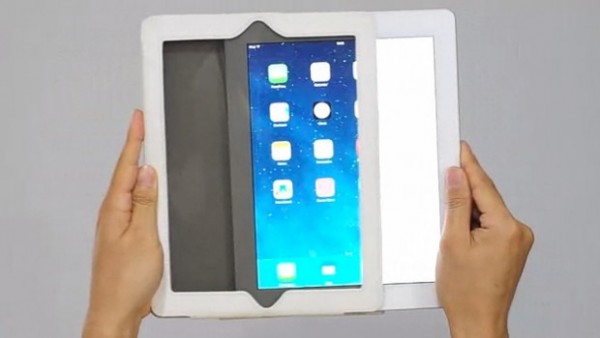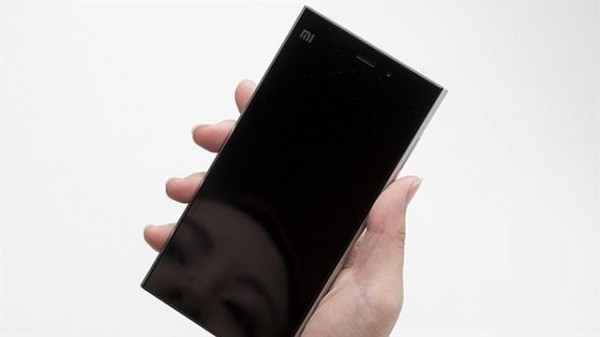Walyou |  |
- i-Spy Privacy Tablet: because these contents are mine only
- 14 Fantastic Ways to Descibe Books Using Only Emojis
- eBay Are Better Than Google at Gender Diversity, Stats Show
- Apple Wireless Wristband Concept to Store Health Data in Hospitals
- Xiaomi Overtakes Samsung as China’s Leading Smartphone Vendor
| i-Spy Privacy Tablet: because these contents are mine only Posted: 06 Aug 2014 08:05 AM PDT  The relationship between a person and the Internet is best enjoyed one on one, without anyone meddling, and that’s what this is meant to ensure. A group of Japanese creators have been working with an interesting hack that renders the display of a tablet invisible to everyone but the owner. The idea is that by taking out one of the polarizers in the display and putting them on a pair of glasses instead, the content will only be seen by whoever is wearing the glasses. This concept is being applied to an Android tablet, a modded iPad Air and a 42? LCD monitor. Privacy at all costs. While we don’t know the specs of the tablet yet the screen is supposed to look completely white unless you’re wearing the polarized pair of sunglasses included with it. The tablet will include a polarizer (depicted in the initial pic) in case you’ve had enough privacy and want to show something to someone else. If you’re excited to see this product hit the market, be sure to check their Kickstarter page where a pledge of $99 will get you your own i-Spy. Via Technabob Be social! Follow Walyou on Facebook and Twitter, and read more related stories about Nvidia's new Android console and the way the Shield Tablet is closing the gap between desktop and mobile gaming. |
| 14 Fantastic Ways to Descibe Books Using Only Emojis Posted: 06 Aug 2014 06:00 AM PDT  Why use words when Emojis fill up our every need of expressing ourselves? Even plots of books can be shortened into colourfol, funny symbols if you put your mind to it. Maris Kreizman suggested that it’s time to replace all the cliched adjectives used to describe books, turning everyone’s attention to Emoji use. Random House decided to hop on the train and began #emojireads, resulting in some excellent and minimalist descriptions. The Hunger Games / Suzanne CollinsNarnia / C.S. Lewis
Old Yeller / Fred GipsonLes Miserables / Victor Hugo
20,000 Leagues Under the Sea / Jules VerneLife of Pi / Yann Martel
Lord of the Flies / William GoldingThe Curios Case of Benjamin Button / F. Scott Fitzgerald
Fight Club / Chuck Palahniuk
The Devil Wears Prada / Lauren Weisberger
The Metamorphosis / Franz Kafka
Infinite Jest / David Foster Wallace
Don’t let the Pigeon Drive the Bus / Mo Willems
The Bell Jar / Sylvia Plath
For more book awesomeness, check out these brilliant T-Shirts inspired by those things you read, or if you’re in a cooking mode, check out these cakes inspired by them as well. |
| eBay Are Better Than Google at Gender Diversity, Stats Show Posted: 06 Aug 2014 05:00 AM PDT  As more and more people begin to ask just why so few women are in technology, new statistics show who is bridging the gender divide best.
In a wonderful turn of events from the, oh, I don't know, past millennia or so (give or take a few centuries) of gender inequality, people are finally beginning to question just why there are such giant gender gaps across certain industries and why. For example, men and women alike use iPhones and Android devices and all of the cloud-streaming, Wi-Fi using gadgets that we talk about this site but for a long time it's mostly been men who are coming up with the ideas for them, putting them together and generally getting to have a say on the things that we all use. Hardly seems fair does it? Especially when Ada Lovelace and Dr. Grace Murray Hooper are two fantastic women whose inventions and thinking gave us the computers and computer programs that we know and love today. Alas, The Wall Street Journal has put together a study telling us who is doing gender diversity the best and the results might just very well surprise you. Leading the pack is eBay who with 42% of its 33,000 workers around the globe being women. Part of that, the company says, is down to their Women's Initiative Network which is a program they set up three years ago in an effort to get women to stay within the company and not migrate elsewhere, with the chance at leadership positions being the dangling carrot at the end of the string. It's working too as 28% of their leadership positions are held by women. (They also say that they actively recruit LGBT folk but there aren't any stats on that at the moment). Meanwhile, Pinterest are in second place with 40%, Yahoo are at third with 37% and Google and Twitter are left squabbling over fourth place as both companies have 30% female employees. Google's results are offset by their various projects to get women in technology, though, so it's a concern but not a great worry (the fact that they made it on the list is probably still considered a win anyway). It's more troubling for any company whose percentage drops below that, not for face value and a place on a list that you can boast about but because companies and groups that aren't homogeneous (i.e aren't made up of the same type of people) actually do better and make more money than those that aren't, likely because the varying opinions make for better products and more informed business strategies. So much for too many cooks spoiling the broth, eh? Source: The Wall Street Journal Be social! Follow Walyou on Facebook and Twitter, and read more related stories, eBay Tells User to Change Passwords Due to Security Hack, ZTE Open C Firefox Phone Goes on an Exclusive Sale on eBay for $99 |
| Apple Wireless Wristband Concept to Store Health Data in Hospitals Posted: 05 Aug 2014 01:36 PM PDT  The Cupertino company has had a great taste for inventions, judging by the great number of patents that were granted by the US Patent and Trademark Office on Tuesday. One of them is a wireless hospital wristband that employs microwave frequencies to transmit health data from patients to the smartphone of their doctor. Even though Apple seemed to have been holding back from all the wearable tech thing, it’s amassing patents over patents, either for itself, or to make sure that others can be sued in case they get the same idea. One of the 58 patents that were granted today to Apple refers to a wireless communication wristband that could change the way doctors interact with the health data pertaining to their patients. The disposable wireless wristband envisioned by Apple would be able to store such data as “medical records, administered medications or procedures [like CT scans] that had been performed on a patient earlier during hospitalization.” More precisely, it packs an “autonomous battery-free microwave frequency communication device” that could easily be embedded in wristbands, flyers and cards. A smartphone running an app developed specifically for this purpose (why lie ourselves, it’s going to be an iPhone and an iOS app) will gather data from the communication device and present it in an easily interpretable form. The iPhone will be able to read the stored data and write any modifications that need to be made concerning the patient’s medication, hospitalization time, so on and so forth. I assume that access would be granted to the wireless hospital wristband after pairing it to the iPhone and entering a PIN or something of the sort. The communication device has a lot of potential, considering the Health app that Apple showcased at its Worldwide Developers Conference in June, and the iTime smartwatch, which the world assumes that will be launched this fall. Fitness and medical issues aside, Apple thinks that this communication device could lead to much thinner wallets, as a single card could act as an ID, loyalty card and credit card, all in one place. I’m not a big fan of Apple products, but that’s something I’d definitely like to see. It is currently unknown if and when Apple plans to launch any products based on the recently granted patents. Be social! Follow Walyou on Facebook and Twitter, and read more related stories about the new Apple patent that suggests that iPhone 6 could pack 3D photography, and the Apple patent that makes texting while walking less dangerous. |
| Xiaomi Overtakes Samsung as China’s Leading Smartphone Vendor Posted: 05 Aug 2014 12:00 PM PDT  An anonymous company not long ago, Xiaomi has managed to take the throne from Samsung as the largest vendor of smartphones in the world’s largest market: China. With 15 million shipped devices that secured Xiaomi 14% of the Chinese smartphone market in the second quarter of 2014, the Beijing-based company outshined Samsung, which only sold 13.2 million smartphones that represented 13.2% of the total. Just to put things into perspective, Xiaomi experienced a growth of 240%. Xiaomi achieved this by doing something that’s unconceivable for manufacturers outside of China. This manufacturer sold its devices at a price that exceeds by a little the cost of the components. While this might not make sense for other manufacturers, it’s perfectly logical for Xiaomi, which keeps its devices on the market for 18 months. In all this time, the cost of the components drops, and the company starts making profit. Besides that, outside of China, the same devices have much greater prices, and even the ones found on Chinese websites are overpriced. Jessica Kwee, a Singapore-based analyst for Canalys, pointed out that “Xiaomi does have the potential to be a disruptive force beyond China and international vendors should take note.” In other words, international vendors should be less greedy and have greater care for their customers, instead of just trying to rob them. It’s really inexplicable how the flagship smartphones coming from big names are twice as pricey as their Chinese counterparts, while clearly underperforming. Xiaomi does not only make top notch smartphones, but also accessories (such as the MiKey shortcut key for Android devices and the Mi Band smart wristband). On top of that, Xiaomi’s custom version of Android, known as Miui, is something that people can’t get on other devices. To make things even better, Miui gets updated weekly, on each Friday, fact that indicates just how much this company cares about its customers’ feedback. The goal of this company is to show that affordable devices (well, not cheap by themselves, but in comparison to others) can be great, thus proving that being cheap is not always a bad thing (Tele2′s Frank the Black Sheep would definitely agree with this.) Ten new markets, including Malaysia, the Philippines, India, Indonesia, Brazil and Turkey will get the chance to buy Xiaomi devices right away, as the company continues to expand. That can only be good news for anyone who’s looking to buy an affordable phone with a stellar performance. Be social! Follow Walyou on Facebook and Twitter, and read more related stories about the Xiaomi Mi4 and Mi Band wearable, and the Xiaomi MI3 gaming smartphone. |
| You are subscribed to email updates from Walyou To stop receiving these emails, you may unsubscribe now. | Email delivery powered by Google |
| Google Inc., 20 West Kinzie, Chicago IL USA 60610 | |